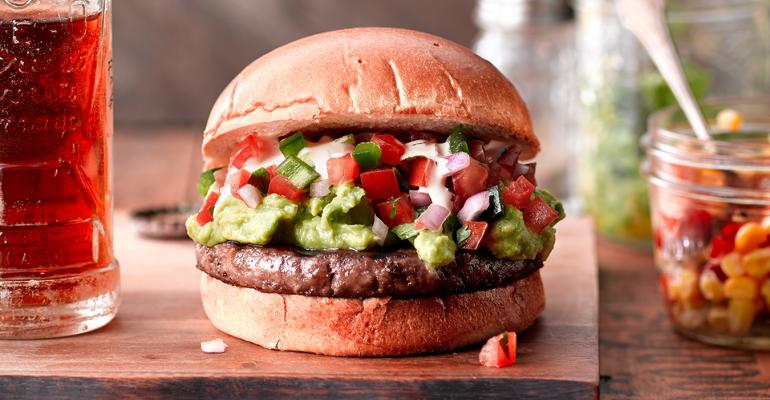Sponsored by Bush Brothers
No longer just an after thought among menumakers, plant-based foods are taking centerstage. Once largely manifested as uninspired side dishes, today they are showcased as key components of exciting appetizers, small plates and snacks.
Plant-based foods—which encompass such ingredients as vegetables, fruits, whole grains, beans, soy, nuts, and herbs and spices—appeal to consumers who are eager to experience menu items that are not only better-for-you but are exciting and flavorful as well. As a result, operators are turning to global flavors to accommodate more adventurous tastes. Serving these dishes in smaller, customer-friendly portions is also expected to fuel their growing popularity.
Meanwhile, interest in plant-based fare continues to blossom. Fifty percent of menu influencers (chefs, managers) and 55 percent of non-influencers (operations managers, general managers) reported increased demand for meatless, plant-forward options over the past 12 months, according to a survey conducted by Informa Engage and Nation’s Restaurant News with Bush’s Best. Respondents also expect the trend to continue, with 50 percent of menu influencers and 51 percent of non-influencers saying they anticipate increased demand for meatless items in the next 12 months.
Think Global, Small Portions
With survey respondents also forecasting increased interest in the cuisines of Asia, the Middle East, Latin America and Europe, meatless plant-based dishes are likely to incorporate globally inspired flavors, they say. In fact, 47 percent of menu influencers and 41 percent of non-influencers say their customers are more likely to try new cuisines if meatless options are available.
In the meantime , chefs and operators are developing menu items that answer the growing consumer demand for plant-based foods, global flavors and small plates. For example, Sodexo chefs partnered with World Wildlife Fund UK and Knorr to develop recipes in line with their Future 50 Foods Report. Future 50 focuses on expanding the variety and nutritional value of foods that people consume because globally, 75 percent of the food supply comes from 12 plant and five animal species. The goal is to eat more vegetables, fruits, grains, cereals, seeds and legumes that were selected for their nutritional value, low environmental impact, flavor, accessibility, acceptability and affordability.
“These are nutritionally dense foods,” says Rob Morasco, senior director culinary development for Sodexo. “It could be chickpeas, red cabbage or more exotic things like amaranth and other ancient grains.”
Some of the dishes Sodexo chefs developed are:
Vietnamese Ancient Grain Bites with amaranth and spelt
- Ube Maitake Mushroom Tartine with purple sweet potato
- Amaranth Falafel and Vegetable Salad with Black Beans, Asparagus and Haricot verts
- Sweet Potato Hummus with Bean Salad
While these dishes can be made for foodservice operations ranging from universities to senior living, they can also be served in smaller portions for catered events. “They are definitely appetizer friendly,” Morasco says. “Vietnamese Grain Bites look like falafel, so we made them as an appetizer for a convention.”
Offer Dishes with Global Flair
No stranger to plant-based menus, Baptist Health South Florida has offered Meatless Mondays and partnered with organizations like the Humane Society of the United States (HSUS ) and others. Some of the most popular foods at the 11-hospital system are globally inspired Mexican and Asian bowls. Menus even feature a Cuban version prepared with plantains and black beans.
“We do have international flair, from Caribbean to Indian spices to Mediterranean,” notes registered dietitian Terry Ochoa. She says many of the foods use such spices as coriander, cumin, curry and ginger. “We use them here regularly, in our plant-based meals, for our guests, employees and even our patients.”
These menu items can also be made smaller and served as appetizers at events, or for grab-and-go snacks. “Anything you make big you can turn into a smaller plate,” she says. “We do have occasional events where these are being served to our guests and our employees.” Some downsizing suggestions include:
- Cut up flatbreads for shareable appetizers.
- Make fajitas with small tortillas.
- Incorporate grains or legumes into side salads.
Think Plant-Forward Instead
The Flexitarian diet is another trend that is driving menu changes, according to research firm Nielsen. Flexitarian is an unrestrictive concept that emphasizes plant-based foods while allowing for the consumption of meat—in moderation. Nearly 60 percent of U.S. consumers say that having the right dietary balance of both animal and plant foods is important.
To attract Flexitarians, operators are devising dishes that feature plant-based protein but do not eliminate meat altogether. That means, for example, serving a smaller portion of chicken or seafood with fried rice or risotto. However, Morasco says, “Someone might say this dish is amazing but I don’t like kale or amaranth. So we have to have all the options.”
Meanwhile, chefs and operators continue to address these changes in our dietary behavior. So expect to see more combinations of plant-forward foods and global flavors served in the form of small plates and limited portions that encourage adventurous customers to sample these new and exciting menu items.



